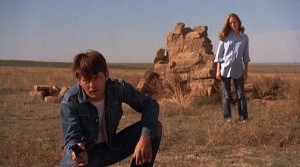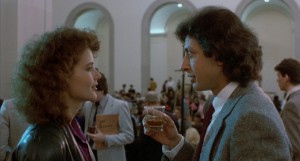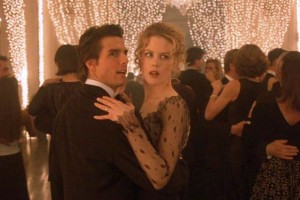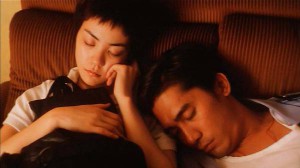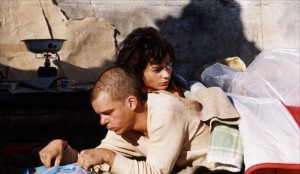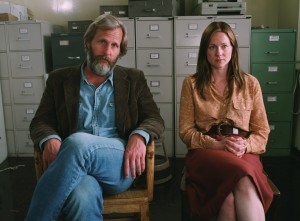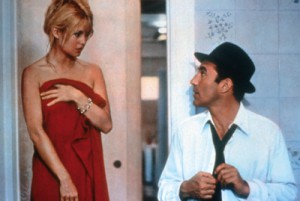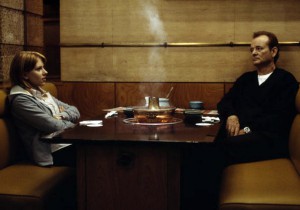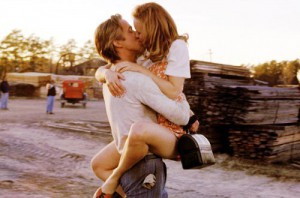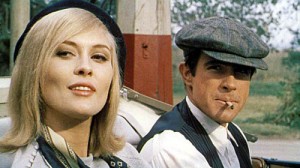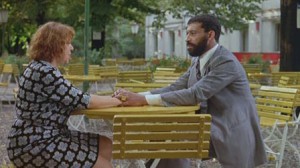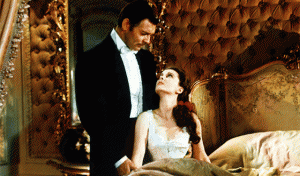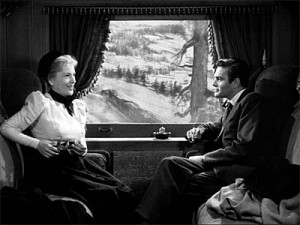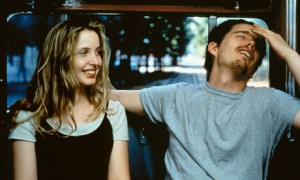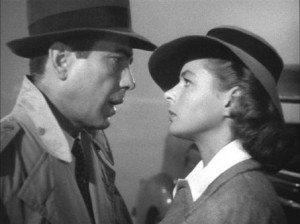Before I met my wife, my longest relationship lasted a span of only three months. I wasn’t afraid of commitment; I was too committed too early. I fell fast and hard. Every time. But that doesn’t mean I never went through the typical relationship bumps in the road. I fought with plenty of exes about normal things – jealousy, dishonesty, etc. And now my wife and I fight about plenty of the same things, but we handle it, just like every other successful couple. In the spirit of tumultuous relationships, this list looks at the definitive relationship dramas. These are films that focus on one or more romantic relationships. These aren’t just “falling in love” movies. These are movies that dissect some side of a relationship that helps to drive the plot. So, without further ado, let’s join hands on this journey together.
50. Wild at Heart (1990)
Directed by: David Lynch
Most of David Lynch’s films are inherently about relationships. That being said, they all focus on twisted versions of real ones, some more unsettling than others. “Wild at Heart” is one of Lynch’s less adored films, though it did take home the Palme d’Or at the Cannes Film Festival. Think “The Wizard of Oz” set to an Elvis soundtrack dipped in a vat of LSD and crude oil. Wild at Heart delivered one of Nicholas Cage’s earliest warped performances, set alongside Lynch regular Laura Dern as a young couple on the run from a controlling mother (played brilliantly by Diane Ladd). Sailor (Cage) and Lula (Dern) reunite after Sailor escapes from jail, having killed a man who attacked him at the request of Lula’s mother. The entire film follows the couple as they meet criminals, gang members, and other bad influences, Sailor seemingly drawn to the criminal life, despite his undying love for Lula. The film is a mess at best, but the central relationship is a highlight that overshadows an otherwise difficult viewing. Say what you will about Cage and his crazy eyes, when he belts out “Love Me Tender” to Dern, it’s surprisingly endearing.
49. True Romance (1993)
Directed by: Tony Scott
You could make an argument that “True Romance” is a comedy, though you could make an argument that every Quentin Tarantino-penned film is part comedy. His first produced movie script, Tarantino’s screenplay landed in the hands of Tony Scott, who made it a traditional narrative and changed the unhappy ending; Tarantino originally objected, but recognized its necessity after seeing the final film. The movie follows Clarence (Christian Slater) and his prostitute girlfriend/wife Alabama (Patricia Arquette) as they try to escape her pimp, crime bosses, and the life she wants to leave behind. After Clarence kills Alabama’s pimp, he grabs what he thinks is the pimp’s possessions, only to learn it’s a bag of drugs he was planning to sell. This sets the road movie in motion, as they are chased by mafia boss Vincenzo Coccotti (Christopher Walken) and his henchmen, resulting in a lot of bloodshed, to say the least. Tarantino puts his skill with dialogue on display early, though he had yet to mold it into a true art yet. But despite the ludicrous action and somewhat overdramatic story, Clarence and Alabama’s courtship is really sweet, even among all the deadly face offs and corkscrew stabbings. Love conquers all, right?
48. A Single Man (2009)
Directed by: Tom Ford
The relationship that drives “A Single Man” never occurs during the actual course of action in the film; it’s seen completely in flashback. Over the course of one day, we learn about George Falconer (Colin Firth), a homosexual British professor who has decided to kill himself that evening, still reeling from the unexpected death of his partner Jim (Matthew Goode) eight months earlier. He is visited during the day by his friend Charley (Julianne Moore), an equally miserable woman who tries to ease his pain, though she does more to try to advance her desire for him than actually supporting her friend. During the day, George comes in contact with various other men who could fill the void he’s felt, including Kenny (Nicholas Hoult), a young man who tries to jump beyond the teacher-student relationship pretty quickly. But, while George entertains the possibility briefly, his yearning for Jim and his lost love still dominates his life. It’s a pretty rough film, but Firth is amazing in it (much better her than in his Oscar winning role for “The King’s Speech”). The beautiful way the film handles the flashbacks and relationship of George and Jim is touching and honest, really giving the film its life blood, despite none of it actually occurring during the course of what is the live action of the movie.
47. The English Patient (1996)
Directed by: Anthony Minghella
During World War II, a nurse named Hana (Juliette Binoche) tends to a critically burned man who goes unnamed (Ralph Fiennes) (this is “The English Patient”). Meanwhile, she begins a relationship with a British bomb defuser named Kip, despite her fear that her presence is a curse upon her friends and family. They are joined by a Canadian operative named David (Willem Dafoe), who begins to question the patient. The patient tells his story: he is a cartographer named Laszlo who was mapping the Sahara. He began an affair with a woman named Katharine (Kristen Scott Thomas), there on the expedition with her husband. When the war begins, it forces their separation. It turns out, David is there to avenge the loss of his thumbs in an interrogation; he’s taken care of two and Laszlo is number three. So, Laszlo continues his story, doing everything in his power to push the blame to Katharine’s husband Geoffrey (Colin Firth). Hana listens to the whole story and, in the end, wants to ease Laszlo’s pain. The film won the Best Picture Oscar (though history leans more in the direction of “Fargo”), as well as an Oscar for Binoche. Minghella’s life was tragically short – he died at 54, having only directed nine films. Of the filmography, The English Patient received the most acclaim, thanks to its sweeping story and wonderful performances. Nothing like the backdrop of war and death to jazz up your love story.
46. Blue is the Warmest Colour (2013)
Directed by: Abdellatif Kechiche
Another Palme d’Or winner, “Blue is the Warmest Colour” set the film world on fire with its brutally honest portrayal of young love, also becoming the first film to have the award presented to both the director and his lead actresses, Lea Seydoux and Adele Exarchopoulos. Adele is a fifteen year old girl who one day sees a woman on the street with bright blue hair. She immediately becomes obsessed with her, eventually running into her again at a lesbian bar. Her name is Emma (Seydoux) and the two become close, eventually beginning a romantic relationship which Emma’s parents welcome, but Adele keeps hidden from her conservative parents. The film follows their up-and-down relationship, focusing on Adele’s difficulty to grow into the relationship and change with Emma, who is maturing and pushing Adele to become an individual. Adele wants nothing more than to stay subservient to Emma, like her border collie awaiting instruction on her next move. The complex discussion on young love vs. mature love is heartbreaking, due to Exarchopoulos’ brilliant performance and the lack of censoring. It’s graphic – Kechiche has since been accused by the actresses of forcing them to perform some of the acts in an aggressive manner. But what results is a touching film that earned an NC-17 rating for nothing more than being visually honest.
45. Certified Copy (2010)
Directed by: Abbas Kiarostami
A French movie written and directed by an Iranian filmmaker, “Certified Copy” starred William Shimell in his first film role as writer James Miller, the only character with a name in the film. James is in Tuscany to discuss his new book that shares the title of the film, explaining that every piece of art – whether a reproduction or not – is original, as every piece of art is essentially a copy of something else. He meets an unnamed woman (Juliette Binoche) and her son, who wants him to sign a number of books, though she must leave when her son misbehaves, leaving James her phone number. The next day, James and the woman meet and they drive to the country while James signs the books. They visit a museum and go to a cafe for coffee, mistaken for a married couple multiple times. They play along, much to the delight of the woman. Upon their departure from the cafe, suddenly their relationship seems to change and things appear very different than what they originally seemed. The beauty of Kiarostami’s film is how comfortable his central relationship is, with both Shimell and Binoche feeling authentic as both perfect strangers and people who may know each other much better than is originally let on. When all is said and done, the best relationship films center on how the couple talks to each other, their comfort with each other, and how that translates on screen. “Certified Copy” is one of the best examples of that.
44. Badlands (1973)
Directed by: Terrence Malick
From a film that hinges on the couple’s communication to a film that succeeds despite the frustratingly disconnected relationship, Badlands is Terrence Malick’s debut film. “Badlands” follows a young Sissy Spacek as Holly, a teenager in South Dakota, hoping to one day get out her dead end town. One day, she meets Kit (Martin Sheen), a young greaser who convinces her to run away with him, though his on-the-surface charm covers a mysterious psychopathic streak, eventually leading to violent outbursts and multiple murders. All the while, Holly narrates the story, explaining her love for Kit in the most childish, naive way possible, clearly not understanding the true ramifications of his actions and the blind eye she repeatedly turns to it. Voice-over narration more often than not feels like a shortcut; a lazy way to add exposition that could be achieved in more creative ways. But Malick’s flm depends on Holly’s immature point of view and her idealistic view of a warped relationship. As with all other Malick films, the landscapes are epic and the cinematography is breathtaking. But, at the heart of “Badlands” is a scared little girl who wants to grow up faster than she should be and how a premature misunderstanding of love can do more harm than good.
43. Breaking the Waves (1996)
Directed by: Lars Von Trier
As with most von Trier films, “Breaking the Waves” is a brutally depressing look at life and its failures, leaning toward Bergman-level criticisms of God and faith, providing a rare silver lining. This film’s central relationship is between Bess (Emily Watson) and Jan (Stellan Skarsgard). Bess is already an outcast in her community; marrying Jan, an atheist, is a major disgrace to her church. Jan leaves to work on an oil rig and, in a moment of loneliness, Bess prays for his return. The next day, Jan is injured and returns home, now paralyzed and unable to sexually perform. Jan requests that Bess begins to have relations with other men and describe to him the details, as it will mimic their being together. Bess at first resists, only to have her dedication to Jan overtake her, as she begins to take the most warped version of his request to heart, allowing herself to be sexually brutalized in the hopes that her pain will somehow give God reason to cure Jan. While many of von Trier’s films focus on a main couple (Antichrist, for one), this is really the only one that feels like it has a tinge of heart. While the acts committed and requests made are ludicrous, Watson’s performance as simple-minded Bess is incredible, and her devotion to her husband somehow feels genuine, given the circumstances. It may be the darkest film on this list, especially given the less than happy ending.
42. Faces (1968)
Directed by: John Cassavetes
John Cassavetes is easily one of the masters of relationship drama (as you’ll see in the rest of this list). His films, normally shot in cinema verite, are dirty and realistic, tending to focus on the difficulties of marriage and courtship. “Faces” is the story of a disintegrating marriage and the aftermath of the the husband Richard’s (John Marley) sudden declaration that he wants a divorce. We follow Richard as he joins a group of businessmen and prostitutes for the evening and follow his wife Jeannie (Gena Rowlands) as she goes out with her girlfriends and an older playboy. Nothing much else happens, other than jumping between conversations and revelations about the pain of the modern relationship, the impossibility of keeping yourself happy, and the pure acceptance of a life of misery going forward. Not a happy film by any stretch of the imagination, but still a refreshing approach to a non-sugar coated narrative about the real trials and tribulations of love and marriage. Not all marriages suck. But if we all understand that even the best ones can still occasionally get a little monotonous, it might help us in the long run.
41. Antichrist (2009)
Directed by: Lars von Trier
A brutally dark look at the aftermath of a child’s death on the parents, “Antichrist” is more a dissection on the stage of grief than it is a relationship drama, but it certainly has a heavy focus on what the man and woman’s role within the relationship and the world is. Antichrist stars Charlotte Gainsbourg and Willem Dafoe as two unnamed parents whose son dies when he falls out a window while they having sex in the shower. And that’s just the beginning. Dafoe is a psychiatrist who has decided the best way for her to deal with her grief is for them to go to their cabin in the woods in solitude, forcing her to confront her fear in a type of immersion therapy. While there, the two begin to dissect each other (in more ways than one), as Dafoe discovers that Gainsbourg appears to be more mentally unstable and complex than he ever imagined. It’s best not to get into the details, but suffice to say, some graphic things happen, as the two (Gainsbourg mostly) begin to act out their greatest fears by inflicting pain and suffering upon each other with some wood, a drill, a grindstone, and scissors. It’s stomach-turning. But it’s also a weirdly visceral, however overblown look at the disintegration of sanity in the face of loss and grief and how those closest to you will always suffer if you refuse to let them in.
40. Don’t Look Now (1973)
Directed by: Nicholas Roeg
A few films that could be defined as horror appear on this list, mostly because the best ones veer further into a psychological discussion on dealing with fear, death, and loss. Based on a short story by Daphne du Maurier, “Don’t Look Now” is a landmark of British-Italian cinema, thanks to its wonderfully developed characters and realistic depiction of grief. John and Laura Baxter (Donald Sutherland and Julie Christie) travel to Venice, still reeling after the accidental drowning of their daughter Christine. While there, Laura meets a psychic who claims that Christine is still trying to contact them, which she shares with John, who is skeptical. Slowly, John begins to experience supernatural moments and mysterious sightings, some of which appear to be a young girl in a red coat, similar to the one Christine was wearing when she died. While the major focus of the story is on John’s obsession with this figure and his mental deterioration (despite his concern for Laura’s mental state), John and Laura’s indisputably honest relationship and the way they deal with their loss is a wonderful dissection of the psychological science of grief, providing an interesting take on the stages of grief from both protagonists’ points of view. Without the Gothic ghost story elements, “Don’t Look Now” still remains a brutally honest look at a broken relationship where both parties are trying to put the pieces back together in very different ways.
39. Titanic (1997)
Directed by: James Cameron
The movie that launched a thousand ships that hit a thousand icebergs, James Cameron’s behemoth Best Picture winner was a giant love letter to the romantic dramas of yesteryear, jacked up with an effects-laden final act that blew previous blockbusters out of the water (pun intended). Taking place on the famed 1912 ship, “Titanic” focused on poor artist named Jack (Leonardo Dicaprio) and his whirlwind romance with upper class passenger Rose DeWitt Bukater (Kate Winslet), a woman engaged to be married, but unhappy with her privileged life. It’s the love story that dominated the box office and made the world fall in love with Dicaprio, and despite it becoming the butt of some jokes in retrospect, it really sells the overdramatic romance pretty successfully. It’s told entirely in flashback by an elderly Rose, but the lasting image will always be Winslet and Dicaprio on the bough of that ship. Kings of the world indeed.
38. The Fly (1986)
Directed by: David Cronenberg
From an overblown epic that shoves love down your throat to a modern horror masterpiece that says more about dedication and love than most romance films. David Cronenberg’s “The Fly” is a remake of sorts of the 1958 horror classic, but is a ton more graphic and way less funny. The memorable images from Cronenberg’s film are the body horror elements when Seth Brundle (Jeff Goldblum) begins his transformation, but central to the film’s heart is his relationship with journalist Veronica Quaife (Geena Davis), who he promises exclusive story rights to as long as she keeps his experiment secret. They meet in a professional sense, but slowly begin a courtship, all while Seth continues his experiments. His major breakthroughs are shared and somewhat triggered by his relationship with Veronica; the beginning of his transformation is actually begun by a poor decision made when his jealousy hits a high point, causing him to misuse his creation. We join Veronica as she watches the man she loves disappear in front of her, piece by piece. It’s disgusting, stomach-turning, and stunning, but it’s also incredibly heartbreaking.
37. Tokyo Story (1953)
Directed by: Yosujiro Ozu
Love is all well and good at the beginning, but eventually that marriage get decades old. And the children from that marriage get older and have their own lives. “Tokyo Story” centers on a retired couple named Skukichi and Tomi (Chishu Ryu and Chieko Higashiyama). They have five children, all grown, one of which lives with them. The film follows them as they visit their children. Their eldest son is married with two children, but pays little attention to them. Their eldest daughter is also married and also has little time for them. The two children pay for their parents to stay in a spa, but they leave early thanks to the volume of the nightlife. The only person who seems to care is Noriko (Setsuko Hara), the widow of their deceased second son, who takes them on a sightseeing tour of Tokyo. While the main focus of Tokyo Story is the sadness that comes with the seeming rejection some children show their parents as they get older, at the heart of that pain is an elderly couple who have worked hard to stay together for so long and raise what they thought we good children. It’s often listed alongside some of the greatest films of all time, thanks to Ozu’s eye and the brilliant performances from the leads. Sometimes death isn’t the worst thing about getting older; sometimes it’s rejection by those who are supposed to love you and take care of you.
36. Eyes Wide Shut (1999)
Directed by: Stanley Kubrick
The final Kubrick fill took the bigger Hollywood power couple and put them against a backdrop filled with insecurity, distrust, and orgies. Lots of orgies. Tom Cruise stars as Dr. Bill Harford, half of a young couple from New York that also includes his actual wife at the time, Nicole Kidman. After a marital dispute with Alice (Kidman), Bill goes out into the city, eventually ending up at a country mansion in a costume and mask, where a strange sexual ritual is taking place. After being forced out, he becomes obsessed with the party, trying to return multiple times, learning that his infiltration has caused problems for connections he has within the society. For the first time, we see Cruise as a flawed human, rather than a traditional masculine hero. Here, he has difficulty with jealousy, believes his wife will stray, and feels inadequate next to other more adventurous men. While not many marriages have problems materialized in the form of an secret masked orgy party (I would guess only about 15%), Kubrick’s cold, disconnected style de-sexualizes the nudity, creating an erotic sterility that, in Bill’s eyes, is less exciting than it is shameful. Sex is supposed to be an expression of love and desire; but what happens when you don’t feel loved or desired?
35. An Unmarried Woman (1978)
Directed by: Paul Mazursky
An almost comedy that kicks off with a relationship ending, “An Unmarried Woman” stars Jill Clayburgh (Oscar nominated) as Erica, the wife of a New York stockbroker (Michael Murphy) who immediately finds herself back on the market after he leaves her for a younger woman. From there, it’s a woman’s journey through life singularly. Erica life has basically fallen apart and now she has to define herself as a person rather than the spouse of another person. The film moves through sexual liberation themes and the importance of being happy with oneself first, with the help of close friends and family. Sure, in the end she finds love again, but Mazursky’s film isn’t about the need to find another. Of all the films on this list, “An Unmarried Woman” may be the only one where, for most of the film, there is no solid relationship. But, Erica’s journey says more about how relationships can function as a reflection of happiness in the face of pain or as an unwanted anchor on the ocean of life, whether the captain of the boat knows it or not. Sometimes the best way to understand a relationship is to be forced out of one unwillingly.
34. All that Heaven Allows (1955)
Directed by: Douglas Sirk
A 1950’s class romance, “All that Heaven Allows” stars Jane Wyman as a wealthy widow named Cary, who doesn’t do much but hang out with friends, fend off suitors, and talk to her college-aged children. When she comes across her gardener, a young man named Ron (Rock Hudson), she finds herself infatuated with him and his simplistic lifestyle. he is respectful, kind, and has no need for the materialistic lifestyle she lives. She finds herself drawn to this way of living, and accepts his eventual proposal. But what begins as love slowly becomes abandonment, as Cary bends under the pressure of her friends and children, who react strongly to her breaking of class rules and this unacceptable marriage to a much younger, much poorer man. She breaks off the engagement, though she is clearly lonelier now that they are apart. The children plan to move out and, because they feel bad for ruining her life, buy her a TV. Because that’s how you fix things. It’s a glossy, overstated romance that hits all the stereotypical notes, but it still stands above most of the other melodramas of the time, thanks mostly to the involvement of director Douglas Sirk. Among Sirk’s 1950’s romances, “All that Heaven Allows” hit the right notes with Hudson and Wyman, making for a well-received feature film.
33. Days of Wine and Roses (1962)
Directed by: Blake Edwards
The budding love of a PR guy and a secretary that hinges on social drinking. Is there any better kind? “Days of Wine and Roses” stars Jack Lemmon as Joe Clay. He meets Kirsten (Lee Remick), a secretary, who is at first hesitant, then jumps right in. They get married and have a daughter, eventually drinking themselves into demotion and near death. After a revelation, Joe decides that he and Kirsten need to get sober. Works for a while, but only briefly. Eventually, it’s clear that Joe and Kirsten’s relationship is what is driving their lack of sobriety, finding solace in the other as they indulge together. It’s clear that, while Joe may have begun the cycle by introducing Kirsten to drinking, she has since gone to a darker place, unable to admit she is an alcoholic and unable to accept that their lives are better apart. “Days of Wine and Roses” is essentially a long commercial for Alcoholics Anonymous, but Remick and Lemmon play so well off of each other and develop a convincing camaraderie that it makes it all the more heartbreaking when Joe recognizes the toxicity of their marriage. But, while Joe and Kirsten’s relationship is the central one, the real relationship is between the two protagonists and, well, booze.
32. Chungking Express (1994)
Directed by: Kar Wai Wong
Two romances that have no connection other than they involve police officers, “Chungking Express'” first story is about He Qiwu (Takeshi Kaneshiro), a cop also known as Cop 223. He was dumped by his girlfriend on April 1 and has decided to wait until May 1 (his birthday) before truly moving on. At that point, he will known whether they will be reunited or they will never be again. The night of May 1, he meets a woman in a wig (Brigitte Lin) at a bar, who comes back to his place, only to fall asleep. The next morning she leaves; he goes to the store, where he meets the new cashier, Faye (Faye Wong). Story 2 then begins, when Cop 663 (Tony Leung Chiu-Wai) meets the same Faye. He is also dealing with a breakup; she begins to fall for him. His ex-girlfriend leaves a letter for him at the snack bar, which everyone assumes is a breakup note. In the envelope is a set of keys to Cop 663’s apartment, which Faye steals and uses to get into his home and “redecorate.” The two eventually schedule time together, but just before their first date, Faye leaves to travel the world as a flight attendant (his ex-girlfriend’s job). He searches her out, but the film is deliberately left open-ended. The style is the real star of the film, as Wong follows an example set by the French New Wave by jettisoning story and structure for a looser interpretation of life and these relationships at their core. Does anything really every go anywhere? That’s not really the point. The point is the journey, however mundane.
31. Blue Valentine (2010)
Directed by: Derek Cianfrance
It’s either a wonderfully honest look at the beginning and slow death of a marriage or a terribly depressing chore with broken narrative. “Blue Valentine” stars Ryan Gosling and Michelle Williams as Dean and Cindy, a young couple who rush into marriage when they learn Cindy is pregnant (though it is most likely from her previous boyfriend). The beginning of their relationship is intercut with a weekend five years later, which exposes Dean’s drinking problem and the intense arguments they have, thanks also in part to Cindy’s job at a medical clinic. Cianfrance’s editing and story structure adds a contrast the film needs to paint a picture that says even the couples that seem happiest can deteriorate if other factors enter the picture and insecurities end up taking control. The lead performances are realistic enough, though the story becomes a chore as we suffer the valleys of this marriage far more than the peaks. But, clearly that was kind of the point.
30. The Lovers on the Bridge (1991)
Directed by: Leos Carax
A romance the way only Leos Caraz could do it. “The Lovers on the Bridge” is a love story between an alcoholic, drug-addicted street performer named Alex (Denis Lavant) and a vagrant painter named Michele (Juliette Binoche) who lives on the streets after a previous relationship ended. She now suffers from an unkown disease that is slowly making her blind. The two live on the Pont Neuf, the oldest bridge in Paris, closed for repairs for the duration of the film. As Michele loses more and more of her sight, she has to depend on Alex to get her through the days. After a treatment is discovered, Michele’s parents try to find her using posters on the street and radio announcements. Alex, realizing that her health would remover her dependence upon him, does everything in his power to keep Michele from knowing her family is looking for her. What results is a film that is altogether reckless and heartwarming, with sweeping romance that can be felt beyond the visuals. It’s still Carax’s most successful film, premiering at the Cannes Film Festival in 1991. It manages to tell a very Paris-themed story without making it a love note to the city, as the love not it portrays is strictly between its two leads.
29. The Squid and the Whale (2005)
Directed by: Noah Baumbach
Another movie about divorce, “The Squid and the Whale” is a complex drama starring Jeff Daniels as Bernard and Laura Linney as Joan, the parents of two boys named Walt and Frank (Jesse Eisenberg and Owen Kiline). Bernard was once a successful novelist, but has since slowed and focused more on teaching. When Joan begins to get acclaim for her own writing, it ramps up the tension between the two, resulting in the divorce and custody battles. Walt and Frank find themselves eventually taking sides with a parent, drifting more to Bernard’s side. Their relationships begin to splinter and the two begin to act out in various ways. For Walt, it’s wildly misrepresenting his achievements. For Frank, it’s drinking and masturbating at school. It isn’t until Walt begins to see a school psychologist that he begins to look at his parents objectively and mine his memory for any reason why he would favor his father, who was relatively absent when he was younger. Baumbach has a tendencies to infuse quirky comedy into his otherwise dramatic films and this one is probably the best of his filmography, as it doesn’t lean so heavily on the comedy side of the writing and takes a subtler approach to its characters and their flaws. Eisenberg was the breakout star of the film, but the honest portrayal of a marriage falling apart from the children’s perspective is done with more purpose, rather than the broad strokes that tend to be thrown at the kids who begin to pick sides.
28. An Affair to Remember (1957)
Directed by: Leo McCarey
An updated version of 1939’s “Love Affair,” “An Affair to Remember” was almost a shot-for-shot remake, substituting in Cary Grant and Deborah Kerr for Charles Boyer and Irene Dunne. The film follows Nickie (Grant) and Terry (Kerr) as they meet on a cruise ship, he being a wealthy playboy, she be already attached to another. The two begin a friendship and eventually fall in love. When they depart the ship, they plan to meet at the top of the Empire State Building in six months, but only if they have both ended their relationships and begun their new careers. On that date, Nickie waits at the observation desk, unaware that Terry, in a rush to meet him, has been struck by a car and can no longer walk. From there, it’s a back and forth between Nickie’s misunderstanding of the situation and Terry’s fear about her condition. It’s a 1950’s romance, so it’s packed full of cheesiness and schmaltzy dialog (the closing lines alone are enough to make you gag). But underneath all that is a beautiful story of love conquering all and how chance encounters can change our fates. It was remade again in 1994 and serves as a pretty clear inspiration for “Sleepless in Seattle,” but unlike Nora Ephron’s 1993 film, this one dissects an existing relationship, rather than creating one for the closing moments.
27. Days of Heaven (1978)
Directed by: Terrence Malick
Malick’s second film after “Badlands,” “Days of Heaven” takes the sweeping cinematography of his debut and softens it, showing the Midwestern wasteland that looked so dirty in Badlands and making it almost majestic, among glorious fields of corn. After Bill (Richard Gere) mistakenly kills his boss at a Chicago steel mill, he and his girlfriend Abby (Brooke Adams) and sister Linda (Linda Manz) run to the Texas panhandle; Linda narrates the story. Bill and Abby pretend to be siblings as the three are hired at a farm for seasonal work by a shy, but extremely wealthy nameless farmer (Sam Shepard). They learn he is dying and hatch a plan to have Abby marry the farmer, only to inherit his wealth after his death. After the ceremony, Bill stays on as an employee. The farmer’s health remains stable, leading to Abby’s feelings to unexpectedly grow for him, obviously causing conflict with Bill. Malick’s camera – as always – tells a pristine story, but what really drives the plot is Linda’s narration, delivered in a jittery, half-knowing way. She gives insight, but she is never really a dependable narrator. And, in such a warped triangle, maybe that’s for the best. Malick has since honed his approach, for better or worse. Many maintain his first two films are still his best.
26. Love Story (1970)
Directed by: Arthur Hiller
From the art house standard of relationships to the cheese-soaked love and death story of the 1970’s, “Love Story” will forever be defined by its incredibly stupid tagline (“Love means never having to say you’re sorry.) and its earworm of a piano theme. Starring Ryan O’Neal and Ali MacGraw as Oliver and Jenny, a pair of college students who meet at the Radcliffe library – Oliver a Harvard student, Jenny a Radcliffe student. The two quickly fall in love and move in together. Eventually, they want to start a family, but can’t, due to an unknown illness Jenny has, which appears to be leukemia. Oliver doesn’t tell her what is wrong for a brief period of time, but she eventually finds out and enters costly cancer treatments that Oliver cannot afford. You see where this goes. However bad the movie is; however overdramatic and ridiculous the story and acting are, “Love Story” created an oft-duplicated template for future romance films (and possibly every Nicholas Sparks book). As Roger Ebert put it, Jenny’s disease has one symptom: “…the patient grows more beautiful until finally dying.”
25. A Separation (2011)
Directed by: Asghar Farhadi
A rare foreign Oscar nominee for Best Original Screenplay (as well as winning the Best Foreign Language Film Oscar), Asghar Farhadi takes the commonly used “breakdown of a marriage” storyline and adds multiple layers to it, making for one of the richest depictions of marriage in years. “A Separation” is set in Tehran and introduces us to Nader (Peyman Moaadi) and Simin (Leila Hatami), a couple married for 14 years who share an 11 year old daughter named Termeh (Sarina Farhadi). Simin wishes to leave the country with her family, as she wants to provide a better life for Termeh. Nader refuses, concerned about his dying father. As a result, Simin files for divorce. The court denies the appeal, but Simin and Termeh move in with Simin’s parents. From there, the drama becomes more complicated, as Iranian tradition and religion are brought into the picture, with Nader hiring a housekeeper named Razieh to care for his father. Eventually, conflict arises between Razieh, her husband, and Nader, who finds his father tied to the bed and pushes Razieh in anger, causing her to fall down a stairwell. In the end, while the drama doesn’t all center around Simin and Nader’s relationship, it all eventually filters down to how Termeh views her parents, if she thinks her father is guilty of his accusations, and who she prefers to live with after the divorce. The acting is phenomenal, the writing is superb, and the development of all the major players make “A Separation” not just one of the best foreign films of the last ten years, but one of the best film, regardless of language.
24. Contempt (1963)
Directed by: Jean-Luc Godard
A Godard film starring Fritz Lang? Sign me up. “Contempt” stars Jack Palance as a film producer who hires Lang (playing himself) to adapt The Odyssey into a film. It turns into an art film, which Prokosch (Palance) hates. Instead, he hires writer Paul Javal (Michel Piccoli), whose wife (Brigitte Bardot) suddenly leaves him, after being left alone with Prokosch. The plot of “The Odyssey” lines up with the story of estrangement, while also aligning pretty closely with Godard’s own life. Overall, it’s a pretty simple story about betrayal. But man is it cold. Godard wanted his wife Anna Karina to play the lead, but was pushed by the studio to cast Bardot and take advantage of her look. So, Godard pretty much takes advantage of that, exploiting those curves as every turn. But, at the heart of this somewhat mild French new Wave film is a pretty honest look at what happens when alienation takes the place of dedication and devotion. Piccoli’s performance turns his abandonment into a hero’s voyage, facing off in battles both personally and professionally. One could argue the whole thing is just Godard thanking Fritz Lang for setting a standard, as Javal is trying so hard to maintain artistic integrity, while also gaining financially. In the end, he looks toward Lang as the example, paralleling his love life with that of a filmmaker.
23. Journey to Italy (1954)
Directed by: Roberto Rossellini
Partly based on the Colette novel Duo, “Journey to Italy” is an Italian film starring George Sanders and Ingrid Bergman as an English couple in a seemingly happy marriage traveling to, well, Italy. There, they go to a large piece of property in Naples they have decided to sell. Alex (Sanders) is the businessman of the marriage, a somewhat off-putting man who leans a little to much on first reactions and sarcasm. Meanwhile, Katherine (Bergman) is the sensitive one, using the trip to rekindle memories of an old friend of hers who has since died. The two begin to show major cracks in their armor, as jealousy and multiple misunderstandings between the two start tearing apart their marriage. This reaches a head when the two actually decide it would be best for them to divorce. But, in a surprise turn of events, they seem to reconcile when they take part in a religious ceremony they come across in Naples. It feels rushed, yes. But the way Rossellini manages to get the audience invested in this marriage so quickly, only to see it fall apart and get put back together, is an act of true filmmaking prowess. Bergman and Sanders give solid performances as the couple; who could fall out of love in Italy?
22. Amour (2012)
Directed by: Michael Haneke
Re-reading the synopsis of this film is heartbreaking in and of itself. Watching it is tenfold. Directed by Michael Haneke, “Amour” tells the story of an elderly couple living in Paris. The film begins with Anne (Emmanuelle Riva) found on the bed, deceased and covered in flowers. The film flashes to months earlier, when Georges (Jean-Louis Trintignant) and Anne, both retired piano teachers, are watching a concert for a former pupil of Anne’s. The next morning, Anne suffers a stroke and needs surgery, which goes wrong, leaving her partially paralyzed. Georges becomes her caretaker, promising never to return her to the hospital or nursing home. One day, Anne lets Georges know that she would rather not go on living. After a meeting with the aforementioned pupil, Georges is hopeful that she has turned a corner, only to see her have a second stroke, this time leaving her incapable of speech and rational thought. Their daughter (Isabelle Huppert) wants her put in a nursing home, but George refuses to break his promise. The closing of the film is another level of painful to sit through, solely because Haneke and his actors have created a story so touching and believable that it feels like you are watching your own grandparents or parents. While Haneke’s typical approach is cold and could be seen as unfeeling, in this slowly paced story, it feels necessary. This isn’t a film about the beauty of life or the magic of love. It’s a film about dedication, sacrifice, and understanding that marriage and love are more about doing what needs to be done for your spouse rather than other selfish pursuits.
21. Possession (1981)
Directed by: Andrzej Zulawskiw
Another horror film, the French-German production “Possession” stars Sam Neill as a spy named Mark coming home after a long mission, only to learn that his wife Anna (Isabelle Adjani) wants to get divorced. Mark believes there may be another suitor; she insists that’s not true. He hands over the apartment and their son as part of the settlement, but becomes obsessed with her, finding their son alone in the apartment while she is out. When Mark receives a phone call from Anna’s new lover, he searches him out, discovering Anna strangely and hysterically (though she was prone to that). Mark hires a private investigator to track Anna, who finds her living in a terrible apartment with an amorphous creature with which she apparently is having a relationship. Zulawskiw wrote the screenplay to the film in the middle of a tumultuous divorce, informing the dark, mysterious nature of psychology behind the actions of both Mark and Anna in the film. The first half of the film is an incredibly detailed, unflappable portrait of a marriage falling apart before the second half shifts into horror territory. The leads stand out, especially Adjani, who plays dual roles, thanks to the supernatural themes and twisty storytelling. It doesn’t quite reach the horror-relationship drama mined by the Polanski’s of the world, but it certainly runs well with the hysteria.
20. Love/Chloe in the Afternoon (1972)
Directed by: Éric Rohmer
Originally titled “Love in the Afternoon,” but released in North America as “Chloe in the Afternoon,” this Rohmer film is a tale of possible infidelity, seen through the eyes of a conflicted man. Frédéric (Bernard Verley) is a successful young lawyer who is happily married to a teacher named Hélène (Françoise Verley), who is pregnant with their second child. While Frédéric is in a considerably good place in his life, he still struggles with the loss of excitement he had before he married, when he could sleep with whomever he chose. It wasn’t so much the sex that thrilled him, but the chase itself. Still, he feels that these thoughts and fantasies, paired with his refusal to act upon them, only proves that he is completely dedicated and in love with his own wife. That is, until he meets Chloé (Zouzou), a friend of a past girlfriend, who is trying to get some independence in her life by looking for jobs, though Frédéric believes she is only trying to take advantage of him. The two begin spending time together and Frédéric now finds himself torn between his wife – a woman he loves deeply – and Chloé – a woman he can’t help but feel mysteriously drawn to. It’s an honest portrayal of a conflicted man. Will he or won’t he? Most often, adulterers in films are given at least what they feel is justification for straying. Not Frédéric, who is an excellent example of a human protagonist who is behaving like all men. Doesn’t make him a bad person. Makes him normal. Chris Rock’s 2007 film “I Think I Love My Wife” is an English language remake, but it could never approach the brilliance and multi-layered life of the first.
19. Lost in Translation (2003)
Directed by: Sofia Coppola
I’m not convinced this film was ever meant to be about a romantic relationship, but it certainly dissects the many layers of the importance a friendship has in the lives of anyone, especially in a place that feels or truly is foreign. “Lost in Translation” served a few roles: it announced the adult arrival of Scarlett Johansson, demonstrated that Francis Ford Coppola’s daughter had her own singular voice, and showed a new side to Bill Murray, who proved he could be so much more than a broad comic actor. Lost in Translation follows a aging movie star named Bob Harris (Murray) as he travels to Tokyo to film an ad for a Japanese whiskey, for which he will receive two million dollars. There, he meets Charlotte (Johansson), the young wife of a photographer who seems unhappy about her lot in life, worried her husband cares more about the models he photographs than her. Bob and Charlotte strike up an unusual friendship, both exploring the differences between American and Japanese culture, finding companionship somewhere in lives that feel empty and lonely. Murray was nominated for an Oscar for his performance, mining the depths of his character in a way rarely seen from him before. His work alongside Johansson set a standard for how onscreen platonic relationships should be portrayed, despite the fleeting inference that it could be more. Somehow that possibility, while unlikely, never seems as far fetched as other movies with protagonists so different in age. But Coppola’s film isn’t necessarily about a romance; it’s about how the possibility of romance can cloud minds just as easily as the romance itself.
18. The Notebook (2004)
Directed by: Nick Cassavetes
I feel like a good chunk of readers were only going through this article to see where this film was ranked. Based on the Nicholas Sparks novel, “The Notebook” launched its stars Ryan Gosling and Rachel McAdams into the stratosphere (and into their own short-lived relationship). The movie starts with an elderly couple in a nursing home, as a man named Duke (James Garner) is reading a story to a fellow patient (Gena Rowlands) who is suffering from dementia. Most of the film takes place in the world of this story, where a boy named Noah (Gosling) has a summer love affair with local rich girl Allie (McAdams), only to have her family push them apart as Allie’s mother Ann (Joan Allen) refers to Noah as “trash.” Noah enlists and eventually returns to Charleston and begins to restore a house he had planned to buy with Allie when they were together, convinced that its completion would bring her back to him, despite her being promised to a local lawyer named Lon (James Marsden). Kisses in the rain ensue. Secrets are shared. Revelations are had. Love happens. “The Notebook” is a level of melodramatic romance storytelling that no film in the last 15 years has been able to match. It relies on plenty of cliches and gave birth to the Nicholas Sparks obsession, each movie adaptation of his work getting worse and worse. But somehow, this one hovers just above the drop-off. I’d expect nothing less from the son of John Cassavetes (then again, he did direct “The Other Woman”).
17. Bonnie and Clyde (1967)
Directed by: Arthur Penn
The movie that ushered in a new era of filmmaking, Arthur Penn’s “Bonnie and Clyde” changed the game with its graphic depiction of violence, but also due to its honest portrayal of sexuality. Clyde Barrow (Warren Beatty) and Bonnie Parker (Faye Dunaway) start small, pulling minor heists. Eventually, with the help of Clyde’s brother (Gene Hackman) and despite his brother’s wife (Estelle Parsons), they begin to think bigger, pulling bank heists and becoming more violent. But embedded within this real crime drama is an exploration of the relationship at its core. Clyde is a criminal, but only on a smaller scale. It isn’t until he tries to steal Bonnie’s mother’s car that he meets his match in Bonnie, a young woman bored with her life and thrilled but the possibility of Clyde’s dangerous course. Her influence pushes him higher, but also exposes a possible insecurity in Clyde even he may not have known existed. Insinuations of impotence aside, Clyde becomes Bonnie’s sidekick more than vice versa, as she becomes the logical part of the duo. “Bonnie and Clyde” is recognized as a turning point in cinematic history; part of that is due to the conflict that exists within the historical couple’s romantic partnership.
16. Ali: Fear Eats the Soul (1974)
Directed by: Rainer Werner Fassbinder
A deliberately frustrating film to follow, thanks to the protagonist’s broken English (and equally confusing subtitles), “Ali: Fear Eats the Soul” is probably Fassbinder’s most respected masterpieces, a West German story of love, class, and race. Ali (El Hedi ben Salem) is a Moroccon laborer and meets Emmi (Brigitte Mira) in a bar when he is dared by a friend to ask her to dance. Not only is Emmi white, but she is a sixty-year-old, widowed maid, at least 20 years Ali’s senior. The two form a surprising friendship, only to move swiftly to serious romance, seeing Ali move in with Emmi. Even more surprising, at the first sign of negativity toward their relationship, they marry, only to see their happiness met with universal disdain. Every person from Emmi’s life seems to look down upon her now, partly due to their bigotry toward foreign workers. Eventually, we see Emmi begin to crumble under the pressures, adopting some of the controlling nature of her fellow Germans. Borrowing themes from the Douglas Sirk romances of the 1950s, “Ali: Fear Eats the Soul” is a brilliant discussion of racism and romance in an environment not often seen. Fassbinder’s semi re-telling of #34 on this list is one of the most complete films on the list, an incredible story of two different types of oppression framed in a world not typically seen in today’s culture.
15. Gone with the Wind (1939)
Directed by: Victor Fleming
It’s big, it’s epic, and it lays on the unreal love story pretty thick. Victor Fleming and screewriter Sidney Howard’s adaptation of Margaret Mitchell’s beloved novel needs little introduction. Scarlett O’Hara (Vivien Leigh) lives on the plantation Tara in Georgia on the eve of the American Civil War. She loves Ashley, who is set to marry her cousin. She is pursued by Rhett Butler (Clark Gable), a man her family has a bit of a problem with, partly because he feels the South will get manhandled by the North in the coming battle. So, Scarlett marries someone else, he dies; she is constantly searched out by Rhett, whom she strings along, using her unearned privilege to manipulate everything and everyone around her. In “Gone with the Wind,” we see a universally loved character who actually serves as more of an antihero than anything. At the beginning, Scarlett is not likable. She doesn’t get much better by the end, but she becomes a little more self-dependent. So, when she gets the rejection at the end, at least we think she might land on her feet.
14. Cat on a Hot Tin Roof (1958)
Directed by: Richard Brooks
Based on Tennessee Williams’ Pulitzer Prize winning play, Richard Brooks’ “Cat on a Hot Tin Roof” focused on a Southern family (as did most Williams plays), led by Brick (Paul Newman) and Maggie (Elizabeth Taylor), a married couple struggle with multiple hardships. Brick is dependent on a crutch, having injured himself while drunk. Maggie and Brick are mostly dependent on Brick’s family wealth, coming from his father Big Daddy (Burl Ives). The two have no children; Brick’s brother has a fleet full of them, though they seem relatively unsupervised. The film takes place at Big Daddy’s plantation, where Brick and his brother are informed that Big Daddy will be dead within the year, though he has not been told. From there, we see Big Daddy’s frustration with his son’s laziness and alcoholism, Maggie’s ongoing attempts to get Brick more involved in his father’s life, mostly because she wants to get her hands on the money. The dynamic between Brick and Maggie is the heart of the film, with Maggie’s aggressive influence and manipulative decision-making serving as a major catalyst to much of the film’s conflict. But, when all is said and done, it may be Brick’s inaction that is the cause of the entire family’s dysfunction. Newman and Taylor play exceptionally off of one another, as expected. Much like Williams’ other plays and their film adaptations, the end is never wrapped up in a bow. But, at the very least, the cards have finally been put on the table.
13. A Woman Under the Influence (1974)
Directed by: John Cassavetes
John Cassavetes’ wife Gena Rowlands longed to be in a film that focused on the hardships of the contemporary women of the 1970s. As a result, Cassevetes wrote “A Woman Under the Influence” and gave the starring role to Rowlands, opposite Peter Falk, who invested his own money in the project, he loved it so much. Rowlands plays Mabel, a stay-at-home mom who is incredibly dedicated to her husband Nick (Falk), a construction worker who slowly begins to worry about her. She begins to act strangely around him and other, confusing him and giving him worry that she may be dangerous to herself and others. So, he puts her in a hospital for treatment for six months, staying home with his kids for that entire time, only to prove he has no idea what he’s doing. Upon her return home, Mabel suffers another psychological breakdown, eventually cutting herself during a brief episode. Without a doubt, this is Gena Rowlands’ best performance, a furiously desperate characterization of a woman not too different than many other mothers and wives, but with an edge that is just dark to cause serious worry. But, how far gone is she really? Is this really so far past what a woman stuck inside a house day in and day out with only her children to talk to? And how does a husband recognize the different between normal exhaustion and psychotic break? Rowlands grabbed an Oscar nomination, as did Cassavetes for Best Director. Rowlands won the Golden Globe for her work in what may be Cassavetes best and most layered offering.
12. Jules and Jim (1962)
Directed by: Francois Truffaut
Set during During World War I, “Jules and Jim” takes place in France, Austria, and Germany. The titular characters are played by Oskar Werner and Henri Serre, respectively, who share a strong friendship, thanks to a shared interest in art and the Bohemian lifestyle. They meet several women; one day Catherine (Jeanne Moreau) crosses their paths, a woman who looks strikingly like a statue the two men loved while traveling through the Adriatic Sea. Catherine begins a relationship with Jules, though Jim is equally taken with her perspective on life. Just before the war begins, Jules and Catherine get married, followed by both Jules and Jim enlisting, but fighting for opposite sides. Time and the war passes, and Jim stays with Jules and Catherine, who now have a daughter. Jules confesses that Catherine has been sleeping around. She even begins to seduce Jim, at which point Jules, who is afraid of never seeing her again, gives his blessing for them to marry, just so he can still see her on occasion. Back and forth, Catherine navigates between the two friends, using their relationship has a game of ping-pong, where neither man is ever the end game. Truffaut’s film has influenced plenty of work since, being one the most successful examples of the French New Wave. Love triangles don’t get much more complex than this; equally frustrating and enchanting.
11. Breathless (1960)
Directed by: Jean-Luc Godard
Similar to Bonnie and Clyde, “Breathless” is a film about a relationship shrouded in a crime drama, this time set in France, Jean-Luc Godard’s first feature-length film. It stars Jean-Paul Belmondo as Michel, a young criminal who tries to evoke the movie persona of Humphrey Bogart the best he can. After stealing a car and shooting a policeman, Michel finds himself on the run without any money, turning to his American girlfriend (Jean Seberg) to help. Patricia (Seberg) is a journalism student, selling the New York Herald Tribune in Paris; she agrees to hide him. However, she doesn’t know Michel is on the run. The tension between the two hinges mostly on Patricia, who must choose whether or not to keep Michel as a secret, or to turn him in. He doesn’t make it any easier, trying to seduce her, while simultaneously trying to call in a loan from her family so they can run away together. I won’t spoil it, but the title doesn’t refer to a feeling when falling in love, if you catch my drift. Godard’s trailblazing entry that kickstarted the French new Wave may not stand as his greatest achievement, but it certainly was a great starting point. The film was remade in 1983 with Richard Gere, having nowhere near the effect.
10. Letter from an Unknown Woman (1948)
Directed by: Max Ophuls
To be honest, the relationship at the center of “Letter from an Unknown Woman” barely even exists. It’s more of a longing from one side than the other. But the ways Ophuls structures the film qualifies it for this list. For the run of the story, we hear a voiceover, explaining the moments in these two characters’ lives. Lisa (Joan Fontaine) is a teenager who becomes obsessed with a pianist who lives in her building named Stefan (Louis Jordan). She only meets him once, but maintains her love for him. After her mother announces they will be moving, Lisa runs away, but sees Stefan with another woman. Lisa becomes a respectable woman and is proposed to by a young, family-focused military officer, whom she turns down, still in love with Stefan, a man she has barely met. Years later, she finally spends an evening with Stefan, though he does not recognize her as the teenager who once lived in his building. Eventually, we see that the voiceover is a note that Lisa has written to Stefan, explaining her feelings, her life, and how his simple existence has been the driving force behind her decisions, even after she has married another man. Ophuls films is heartbreaking and, by my estimation, his best offering. In the moments Stefan encounters Lisa, he is inexplicably drawn to her, as she had hoped. If anything, it tries to prove that even the relationships that never materialize can be more important than those that do.
9. Brokeback Mountain (2005)
Directed by: Ang Lee
There had been plenty of movies made about homosexuality before, but most up to this point focused on the eventual pairing of the main couple. In Ang Lee’s critical darling “Brokeback Mountain,” the relationship starts abruptly, allowing the rest of the film to be a slow burn of conflicting emotion and passion, Ennis and Jack (Heath Ledger and Jake Gyllenhaal) herd sheep in the Wyoming mountains one summer. After an evening of drinking, Jack makes a pass at Ennis, who initially rejects his advances, but eventually gives in. Ennis insists it is a one-time thing, but after they leave the mountains and both get married, it’s clear that their feelings remain. Jack searches out Ennis, and the two begin taking fishing trips together. Their marriages crumble – Jack understands much more clearly who he is; Ennis struggles mightily with his sexuality, but is also a loyal man who refuses to move away from his children, even after his divorce is finalized. 1960’s Wyoming isn’t exactly the normal place for a drama on homosexuality, which is what makes it so effective. Lee’s camera captures the sweeping environment, but remains incredibly sentimental and character-focused. Ennis and Jack must deal with their feelings, societal norms, an pe the fear of violence and prejudice in a way not often seen. Homosexuality in movies has been more straightforward and more pointed, but this was one of the first wide release films to truly depict an honest struggle with sexuality in a way that didn’t feel the least bit generic or stereotypical.
8. Brief Encounter (1945)
Directed by: David Lean
Laura Jesson (Celia Johnson) is a middle-class woman in a happy, but boring marriage. “Brief Encounter” is delivered as a story she is telling in voiceover and flashback, imagining she is confessing to her husband the affair the film details. One day on a train, she is helped by another passenger named Alec (Trevor Howard). Both are married and have children. While they have repeated meetings, they find their attraction is much deeper than friendship. Unfortunately, their future is almost impossible to create, as they would need to continuously lie and compound that lie. When a friend allows them to use his flat, but turns a judgmental eye toward them, Laura finds herself shaken, running from the flat and being stopped by police. This leads to their eventual agreement that they must say goodbye – Alec has accepted a position in South Africa. Adapted from a Noel Coward play, the film’s passionate love is seen alongside a desperate need for companionship. Are Laura and Alec bad people for wanting happiness they don’t have? Are they being selfish? The film never answers that question, though there is never a moment in the film where the audience can honestly claim they aren’t rooting for these two. I would never condone an affair of any kind, but if the affair is depicted in any way similar to “Brief Encounter,” it may give me reason to pause for a moment or two.
7. Before Sunrise/Sunset/Midnight (1995)
Directed by: Richard Linklater
I’m cheating, but don’t kid yourself – this is really just one long movie broken into three parts (and maybe more). “Before Sunrise” introduces us to Jesse (Ethan Hawke), an American writer/traveler, and Celine (Julie Delpy), a French student returning to Paris. The two spend a day in Vienna together on a whim, developing a deep connection. We revisit the two nine years later in “Before Sunset” – Jesse has written a beloved book and is on a tour in Paris to promote it. Celine finds him and the two discuss their lives since that night and begin to rekindle some of that flame. We rejoin them nine years later for “Before Midnight,” now a married couple spending a Greek vacation together with their children. They use the time to reminisce of their relationship, their ups and downs, and where they could be if that fateful night never occurred. A few things are clear as we move through the films: Hawke and Delpy get better and better with their chemistry, Linklater’s direction gets more and more clear-minded, and the trio has together created one of the clearest and most honest portrayals of a modern romance ever put on screen. There are plenty of films that came before that touched on the same themes, but this trio of films puts all the pieces together. After Before Midnight, we feel like we know this couple as well as we know our neighbors (even more so) and we understand where each is coming from. All the movies on this list hinge on a relationship or two. Linklater’s films are the relationship.
6. Scenes from a Marriage (1973)
Directed by: Ingmar Bergman
Originally an acclaimed television miniseries in Sweden, “Scenes from a Marriage” ran for six episodes. The theatrical cut is 167 minutes long, down from 281 minutes on television. That in mind, the film is relatively episodic, following Marianne and Johan (Liv Ullman and Erland Josephson) as their ten year marriage deteriorates, thanks to his infidelity and her disillusionment with their relationship and their relationship with their children. As Bergman is the director, it is incredibly scant on surrealism and incredibly detailed and harsh. There is no attempt to infer anything from anything – it’s a pretty straight-up story about a troubled relationship. Close-ups are used regularly to drive home the pain and anguish the two go through. Ullman’s performance is the stand out as a woman who cannot understand why her husband would just simply walk away from something they both built together. It’s surprisingly feminist, showing her growing independence as the two don’t necessarily fall out of love, but transform into a very different relationship, based on much more than just young love. It’s uncompromising and detailed – there are no windows shaded or door closed to this couple.
5. L’Atalante (1934)
Directed by: Jean Vigo
Marriage is tough. Especially when you’re aboard a boat that you can’t really leave. Jean (Jean Daste) is the captain of the titular barge, joined on the boat by his new wife Juliette (Dita Parlo), a crew member named Pere Jules (Michel Simon), and a cabin boy. They head to Paris to deliver some cargo. Jules isn’t quite sure how to handle having a woman on board, but eventually takes Juliette int his quarters, causing Jean to fly into a rage. They arrive in Paris, with Jean promising to take Juliette out, only to see Jules and the cabin boy leave the boat first. Jean cannot abandon the boat. Eventually, they do go out, but Jean’s jealousy causes him to drag Juliette back to the barge. She sneaks back off the boat; Jean decides to leave her in Paris. Clearly, not his best decision, as he slips into a depression and begins to perform poorly at his job, yearning to return to find her. The French New Wave movement of the 1960’s found a great influence in Vigo’s work here, as his poetry of motion and the way it enlivens a story that really just takes place on a cargo barge. While the synopsis sounds like a two-sided drama, it really focuses more on Juliette, who grows tired of waiting and wondering on a boat, hence her “relationship” with Jules and her need to get out and explore Paris. But what “L’Atalante” does is set a gold standard. Films have tried to approach the technical and emotional prowess of Vigo’s master work, but it has yet to be equaled. It’s beautiful, it’s honest, and it’s more gorgeous than most romances you’ll see on screen otherwise.
4. In the Mood for Love (2000)
Directed by: Kar Wai Wong
You could argue that this film is actually about two people falling in love (which I tried to avoid), but it’s too good not to include. “In the Mood for Love” takes place in Hong Kong and centers on a journalist named Chow Mo-wan (Tony Leung) and a secretary named Su Li-zhen (Maggie Cheung), who both begin renting from the same apartment building on the same day. They becomes neighbors, both with spouses who are never around, always traveling for work or with overtime shifts. Chow and Su both secretly believe their respective partners are having affairs and share a common bond, becoming friends. Chow invites Su to help him write a story – people begin to talk. They remain platonic, but both know that feelings are brewing beneath the surface. The relationship (or lack thereof) is one of the more heartfelt and difficult ones to watch as connections are missed and opportunities pass by. According to Time Out New York, it’s the “consummate unconsummated love story of the millennium.” It’s a perfect summation of the film, which turns entirely on the relationship Chow and Su should share, but never do. Plenty of films of this list have themes about possible love never being fulfilled. “In the Mood for Love” may be the best one – a deeply felt, beautiful story of love that never came to fruition.
3. Who’s Afraid of Virginia Woolf? (1966)
Directed by: Mike Nichols
You could argue that Mike Nichols adaptation of Edward Albee’s play is a jet black comedy, but not nearly enough to exclude it from this list. “Who’s Afraid of Virginia Woolf?” takes place over one day. It begins on Sunday morning at the home of George and Martha (Richard Burton and Elizabeth Taylor). George is a professor; Martha is the president’s daughter. She has invited a young couple over for the evening – Nick (George Segal), a newly hired instructor, and Honey (Sandy Dennis), his quiet wife. And this sets everything off. George is all too familiar with Martha’s heavy drinking and it begins as an argument long before their guests even arrive. Nick and Honey quickly realize that they are being pulled into marital strife they have no place being involved in, but George convinces them to stay. And so the dance continues – arguments abound, criticisms are thrown about aimlessly, and Goerge and Martha trade barb after barb while Nick and Honey watch and slowly gets sucked in. The film takes turns that are unexpected and sharp, with Taylor and Burton giving behemoth performances. I won’t spoil where exactly the film goes and ends, but, suffice it to say, it’s a bombastic trip the entire way through. George and Martha may very well be the most dysfunctional couple on this list, but dammit – they may be the most entertaining and interesting, too.
2. Sunrise: A Song of Two Humans (1927)
Directed by: F.W. Murnau
The earliest film on the list and the only silent one, F.W. Murnau’s brilliant story of near betrayal won the Unique and Artistic Production Oscar at the very first Academy Award ceremony (basically, the artistic Best Picture). “Sunrise” introduces us to a Woman from the City (Margaret Livingston), who has been spending time at a little lakeside town. She spends time outside a farmhouse, trying to lure the owner out. The Man (George O’Brien) lives there with his Wife (Janet Gaynor) and their daughter. His farm has been struggling lately – the Woman wants him to sell it and move to the city with her. He finds himself tempted; the Woman’s solution is that he take his Wife onto the lake and drown her. He almost goes through with it, but realizes that he cannot when she pleads for her life. Upon their return to shore, she flees from him and jumps on a trolley into town. He chases her and begs her to take him back. From there, they appear to be reunited, but tragedy causes the Man to once again search for his love and fend of temptation from the Woman. It’s a story that has been copied time and time again, but Murnau’s beautifully shot, wonderfully moving original romantic drama was the first measuring stick – a dramatic look at the pain of infidelity, the strain of temptation, and the difficulties of rural life in a world that has begun to see industrial boom. Films began to view relationships in much more complicated light, but sometimes, there’s nothing better than a good old-fashioned happy story; even when it takes dark turns.
1. Casablanca (1942)
Directed by: Michael Curtiz
It’s the film that every man should return to once in a while. Love isn’t always about passion. It’s not always about showering her with gifts. Sometimes it’s just about sacrificing your own happiness. Michael Curtiz’s Best Picture winner boasts one of the greatest screens plays of all time, led by one of the greatest movie stars to have ever worked. “Casablanca” stars Humphrey Bogart as Rick Blaine, a U.S. expatriate running a nightclub in the title city. Rick comes into possession of some letters that will allow a Czech Resistance leader named Victor to escape to America, planning to bring his wife, Rick’s former lover Ilsa (Ingrid Bergman). From there, the film takes time to discuss the larger stakes of the ongoing war and the danger the characters at this little nightclub face, but the relationship between Rick and Ilsa is what drives the entire film. He finds himself struggling between his bitterness of the dissolution of their past love and his desire to ensure she stays safe. He knows she won’t be happy or easy to protect in Casablanca, but he knows he won’t be happy to let her go again. So, what’s a man to do? Not many films feature such a strong, yet conflicted male lead performance that, despite making the right decisions and being a good person, still doesn’t get the girl in the end. And, occasionally, that’s what audiences need to see. A good relationship isn’t necessarily one that lasts forever. Sometimes, deciding to end a relationship is more important than doing whatever it takes to keep it going.
–Joshua Gaul








